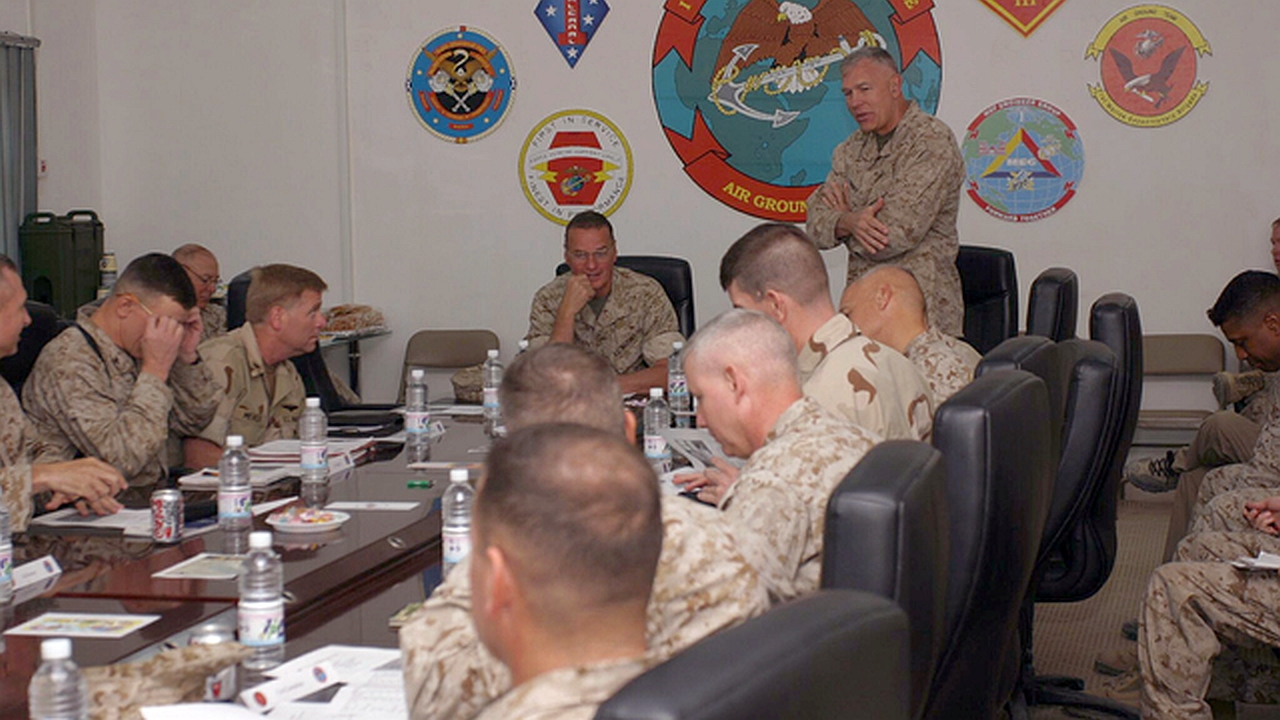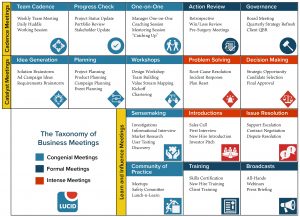
Organization Management Rhythm (part 1.2): Lucid Meetings
This article is part 1.2 of a series of articles on Organization Management Rhythm.
Lucid Meetings is a proud remote first majority woman owned company based out of Portland Oregon. The motto for this company is “We make it easy for teams to run successful meetings every day.” Founder and CEO Elise Keith has given permission to use the companies’ copyrighted material for defining meetings. This series utilizes the meeting types conceptualized, categorized, and describe by Lucid Meetings, as one of the few companies who recognized on the Constellation ShortlistTM in 2017 as providing key functionality and requirements for digital transformation initiatives.
The sixteen types of business meetings for organization management rhythm are grouped into three different categories:
1. Meetings with known participants and predictable patterns
a. Predictable patterns are based upon a cyclic nature. For example, every year there is a meeting on IT. This is a list of the most common frequencies/patterns:
i. Daily
ii. Multiday week (2 or 3 times)
iii. Weekly
iv. Twice monthly (Fortnight)
v. Monthly
vi. Every numeric (2,3,4,5) day of the week
vii. Every other month
viii. Quarterly
ix. Bi yearly
x. Annual
xi. Other
b. These meetings are forecasted out and are used as informational or decisional style meetings:
i. Informational meetings are just to spread the information covered
ii. Decisional meetings are used to decide an outcome
2. Participants and patterns assembled to fit the need
a. Pattern
i. These meetings can be ad hoc
ii. Short term
iii. They are for situational needs only
iv. Cover a specific need such as COVID-19 actions
v. Last only as long as the need is present
vi. Can be a special speaker for a special month
b. Participants
i. Will vary widely based on the subject
ii. Can be large or a small group
iii. Do not limit
3. Efforts to evaluate and influence: meetings between us and them
a. Evaluate
i. These are based upon an inspection of a staff, process, or technology
ii. These are very formal
b. Influence
i. It is designed to change the mind or set a standard (for example, a union meeting for collective bargaining)
ii. It can be done at every level of an organization
The Lucid Meeting group uses three major factors that categorize impacted meetings. The intention, format, and participation profile are three categories that can be used to classify or categorize the sixteen meeting types.
Intention is expressed as purpose and outcomes, why and what – why hold the meeting and what is gained from it? This also incorporates a commitment from the staff.
Format is what rules the meeting must play by. The strength of governing rituals and rules that each meeting follows along with different standards for each meeting classification whether it is military or from Lucid Meetings. Zoom meetings mean the viewed portion of the person must be dressed accordingly, while a surfing meeting may be in wetsuits and on the ocean waves. The rituals and rules if followed have a clear impact on the meeting. Surprises are bad for some meetings but beneficial to others. This is the role of serendipity and tolerance for the surprises.
Expected participation profile is who is expected to be in the meeting. Do not bring additional staff who would distract from the meeting even if there for support. This factor is interaction-based and considers the types of people present. The ways in which assumptions about the people present influence meeting type relate to expected audience, leadership, participation style, and how well the group works together.
The chart of meetings in Figure 1 shows all 16 meeting types, and if they are congenial, formal, or intense. The colors convey the emotional fatigue to these meetings: lighter blue for friendly and non-threatening, dark blue is more social effort, and red meetings are high stakes and too heavy on the cortisol to be healthy every day.
All the meetings in a row share similar perspectives on the organization’s work and involve people in similar ways. The following three sections of this series will look at each of these three groups in more detail: Cadence Meetings, Catalyst Meetings, and Learn and Influence Meetings.

Figure 2 shows an organization’s meeting performance maturity. In regard to the maturity levels 1, 2, and 3:
Level 1 – Most organizations run these types of meetings.
Level 2 – These meetings are normally seen when an organization progresses in size.
Level 3 – This is the more mature organization. These are highly specialized meetings in which the rules are more specialized and the staff participating there are typically from more senior levels of management.

Next part (part 1.3): Cadence Meetings.
Acknowledgements: Thank you to Tomi Antill, Keith Davis, Elise Keith from Lucid Meetings, JFHQ-C Leadership, and Kendra Albright from Kent State University, without whose support this series would not have been possible.
Header image source: U.S. National Archives, Public Domain.






